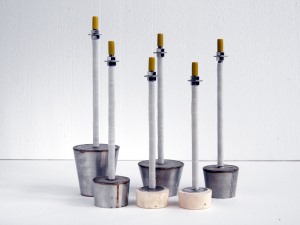4 main reasons for the damage of breathable bricks for ladle
4 main reasons for the damage of breathable bricks for ladle
There are four main reasons for the damage of bottom-blown ventilation bricks, and the ventilation bricks are subjected to external effects during use.
1, the effect of thermal stress
The refractory material on the working face of the breathable brick, especially the refractory material around the air outlet, is in direct contact with the high-temperature molten steel and is affected by the high-temperature molten steel and the continuous outflow of cold air, resulting in a large temperature gradient. Bricks are subjected to rapid cooling and rapid heating, especially near the air outlet, which are subject to greater thermal stress and are prone to cracks.
2, mechanical wear
In the process of tapping, the high speed of molten steel and the strong scouring of the bottom of the steel tank accelerate the damage of the breathable bricks; some people have studied the damage of the breathable bricks through the hydraulic model test and found that when the low-speed flowing airflow is injected into the liquid phase molten pool When the air flow hits back and hits the front of the permeable brick, the refractory material around the gas port is given a certain impact force. When the gas flow rate is further increased, the reverse pulse frequency decreases, but the reverse impact strength further increases; in addition, when the gas flow rate is further increased When argon is blown into the normal spray state, strong bubbles form a gas jet beam, the jet beam strengthens the stirring at the bottom of the steel tank, the liquid phase movement at the bottom of the steel tank is intensified, and the 2-phase plume makes the permeable brick subjected to strong shear and impact stress When the breathable brick is higher than the seat brick, it is sheared by this plume, and the scouring is especially obvious. The part higher than the seat brick is generally washed away after one use; in addition, if the valve is quickly closed after refining, the molten steel will react. The impact will also accelerate the damage of the breathable brick.
After the breathable brick is damaged
3, chemical attack
The working surface of the permeable brick is in contact with slag and molten steel for a long time. During the whole contract, the molten slag continuously infiltrates and penetrates into the brick. The oxides MnO, MgO, SiO2, FeO, Fe2O3, etc. in the molten steel and slag react with the brick:
12CaO plus 7Al2O3=12CaO 7Al2O3
FeO plus Al2O3=FeO·Al2O3
2MnO plus SiO2 plus Al2O3=2(MnO)·SiO2·Al2O3
The generated FeO·Al2O3, 2(MnO)·SiO2·Al2O3, 12CaO·7Al2O3 and other low-melting substances are washed away, causing the permeable brick to be eroded.
4, the role of mechanical stress
The working surface of the bottom refractory material is in direct contact with the high-temperature molten steel, and the temperature of the non-working surface of the bottom refractory material is relatively low. During the cycle of the ladle receiving molten steel → pouring molten steel → hot repairing ladle → receiving molten steel, the temperature of the ladle has been changing. , the volume of the bottom refractory changes accordingly. Due to the existence of the temperature gradient of the bottom refractory and the different expansion coefficients between the metamorphic layer and the original layer of the bottom refractory, the corresponding volumes of the layers from the working face to the non-working face of the bottom refractory The change is different, so as to generate shearing force on the breathable bricks, causing transverse cracks in the breathable bricks, and even transverse fractures in the breathable bricks. If the temperature gradient of the material is too large, the same phenomenon will occur in the breathable brick. In the production practice, it has been found that the ladle that is poured as a whole at the bottom of the ladle is accidentally baked, causing the breathable brick to break into several sections horizontally (see Figure 2).

Related News
- Introduction of construction method of ramming material in intermediate frequency furnace
- How to choose the material of furnace lining
- The difference between rammer and castable
- Application direction of intermediate frequency furnace refining
- Introduction to the construction method of dry ramming material
- Do you know the production process and control points of breathable bricks?
- The application of argon blowing technology at the bottom of the intermediate frequency furnace
- Method for prolonging service life of intermediate frequency furnace lining
- In addition to diffused breathable bricks, there are those types of breathable bricks
- What are the advantages of coil cement
- Analysis of the methods to improve the physical and chemical properties of ladle breathable bricks
- What are the requirements for the production materials of breathable bricks?
- The method and attention problems of carbon increase in intermediate frequency furnace
- Common problems in the application process of diffused breathable bricks
- What are the requirements for manufacturing materials of breathable bricks?
- Analysis of Characteristics of Refined Ladle Dispersion Type Breathable Bricks
- Two common methods of lining the intermediate frequency furnace
- What are the key points for the selection of intermediate frequency furnace lining materials? Do you really know?
- What causes the damage to the furnace lining?
- Introduction to the composition structure and function of ramming material


